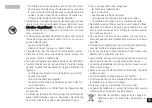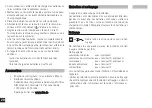
EN
Page
Safety instructions
10
Correct use
12
Unpacking
12
Commissioning
12
Operating
13
Accessories
14
Maintenance and cleaning
14
Warranty
15
Technical data
15
• R
Re
ea
ad
d tth
he
e o
op
pe
erra
attiin
ng
g iin
ns
sttrru
uc
cttiio
on
ns
s iin
n ffu
ullll b
be
effo
orre
e s
stta
arrttiin
ng
g u
up
p
a
an
nd
d ffo
ollllo
ow
w tth
he
e s
sa
affe
etty
y iin
ns
sttrru
uc
cttiio
on
ns
s.. Keep the operating
instructions in a place where they can be accessed by
everyone.
• Ensure that only trained staff work with the appliance.
• Use only the AC adapter supplied.
• Observe the following safety instructions for the hand-
ling of batteries. Considerable material and health dam-
age and personal injury can be caused by:
- Leaking or exploding batteries
- Escaping of the toxic or corrosive substances con-
tained in batteries
- Use only the rechargeable battery types recommmen-
ded in the technical data in the appliance!
Do not use other battery types and on no account
non-rechargeable batteries.
- Never mix different models, types or capacities of
C
Co
on
ntte
en
ntts
s
S
Sa
affe
etty
y iin
ns
sttrru
uc
cttiio
on
ns
s
batteries.
- Be sure to observe the polarity indicated in the bat-
tery compartments! The side of the battery with the
plus sign (+) must be aligned with the correspond-
ingly marked side of the battery compartment.
- Do not charge batteries that have leaked or that are
discoloured, deformed or damaged in any other way.
- Leaking or damaged batteries must be disposed of
while observing the normal precautionary measure
(protective gloves).
- Do not open, dismantle, pierce, modify or throw the
batteries and do not expose them to unnecessary
blows.
- Do not expose the batteries to fire or temperatures
above 50° C. Do not store the batteries in hot places
(e.g. in the car in direct sunlight).
- Do not charge the batteries when the ambient tem-
perature is below 0° C or above 40° C.
- Do not immerse the batteries in water or other liq-
uids.
- Objects made of metal or other conductive materials
(e.g. keys, coins, tools, rings) can cause a short-circuit
in the batteries. Never store the batteries together
with such objects.
- Always replace the batteries as a complete set. Never
use old and new batteries together.
- Never connect the batteries directly to a power
source (e.g. a domestic plug socket or a car battery).
- Never place the batteries in a microwave oven or in
pressurised or vacuum vessels.
- If you charge the batteries in an external charger, en-
sure that the admissible charging current for these
10











































